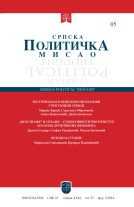- Home page
- Researchers
- Božidar M. Banović
Božidar M. Banović

CRIMINAL POLICY OF THE COURTS FOR CRIMINAL OFFENSES OF VIOLENT PROPERTY CRIME
Violent property crime are acts in which the social danger is very high, and therefore imply an adequate social response. The aim of this research was to examine the criminal policy and effectiveness of the courts in conducting criminal proceedings against adult perpetrators of theft, robbery and extortion. The study was designed as a cross-sectional study. The sample consisted of all decisions of the courts for the criminal offenses of theft, robbery and extortion in the territory of the Republic of Serbia, for which the proceedings were closed, from 2007 to 2012. The data were taken from the Statistical Office of the Republic and relate to the statistical survey of crime, by monitoring the accused and convicted persons for these crimes. The results show the insufficient efficiency of the courts in conducting criminal proceedings and the wide disproportion between the penal policy of the legislator in the form of a suspended sentence and the criminal policy of the courts in the use of the prescribed criminal ranges. Imprisonment is the most pronounced criminal sanction, but its temporal distribution is questionable. A very large number of these penalties are below the legal minimum, which also calls into question the merits of the application of a sentence mitigation institute to this extent. Whether rightly or not, but it is indisputable, that priority is given to mitigating circumstances in sentencing. The research has shown that there is a disproportion between the criminal policy of the legislator, in the form of a punishment, and the criminal policy of the courts, when weighing and imposing sentences for these offenses. An effective approach to crime involves the effective detection of perpetrators, their effective prosecution and the enhancement of the criminal policy of courts within the statutory criminal ranges for these offenses.

RIGHT TO DIGNIFIED DEATH IN SERBIA
In this work the authors explain the problem of deprivation of life from compassion as one of the most complex legal, medical, religious, ethical and social issues. Although it is not disputed that a number of debates around the world are being conducted on this subject and that attention is paid to it, depending on the state to the state, and the culture which the country concerned belongs. The right to life is one of the most important human rights, guaranteed by a number of international and national laws. However, the actual issue in recent years is whether a man, besides that right, has a right to die with dignity. The legislators through the centuries consistently moved the line that separates permissible and impermissible deprivation of life from mercy, either to legalization either towards a complete ban of euthanasia. This issue becomes more relevant if we consider the fact that modern technology allows the extension of life of the terminally ill patients, which can mostly be viewed as positive, but, in some cases, may have resulted to an extension of unbearable suffering of patient. In the most European legislations legislators regulated euthanasia as a privileged form of murder. Such case is in Serbia. Euthanasia is seen as murder, but with specific characteristics, which are primarily related to the absence of opposition from the injured to deprivation of one’s own life and existence of his request or such action. The crime of deprivation of life out of compassion is independent from the crime of murder. The authors approach this issue from a different point of view, linking several different issues into one whole. In the first place, the authors explain the criminal offence of deprivation of life from compassion from the Serbian Criminal Code, and then turn to the explanation of the right to death with dignity envisaged by the Draft of the Civil Code, which inevitably, by adopting this Code, would lead to changes in the Criminal Code. In the end, the authors give the results of the empirical research carried out in the Clinical Hospital Center in Kragujevac in relation to the subject matter.
